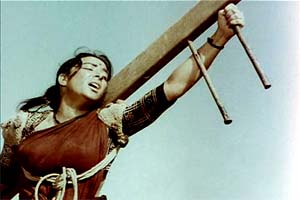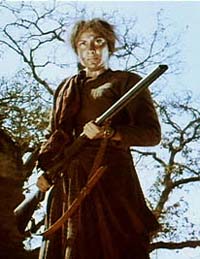Apr 18, 2024
Apr 18, 2024
by Shahla Raza
Characters in popular Indian films are mostly built around cultural stereotypes. Interestingly, in films that focus on violence, women are shown as ones who symbolize non-violence, and who are able to influence men to give it up for the sake a lawful, peaceful calling. This might be a stereotypical image that runs counter to the fact that many women were known to have taken part in the 1993 communal riots in Mumbai, and in the 2002 Gujarat riots. But the portrayal of women in films as being on the side of law, and as those who try to wean men away from the path of destruction, sends out a strong message. During the Freedom Struggle, Mahatma Gandhi challenged the association between strength, violence and manliness through his non-violent satyagraha. He also succeeded in mobilizing women on a large scale and motivating them to join his movement of passive resistance. By invoking the example of figures from mythology like Sita, who endured suffering in silence, Gandhi's message to Indian women was: If non-violence is the law of our being, the future is with women. The 1960s - the era of romantic films - also saw the rise of the archetypal angry young man. A notable number of films in this period had male leads playing an outlaw. The female character in films of this genre represented family and therefore stability and peace as opposed to the violence represented by the male character. 'Reshma Aur Shera' (1971) also focused on the theme of the violent male versus the peaceful female. In this interesting reworking of Romeo and Juliet, Reshma and Shera are star-crossed lovers, belonging to rival clans. When Shera takes to violence to avenge the killing of his beloved's family, Reshma sacrifices her own life to bring him to his senses. 'Parzania' (2006), which depicts the 2002 Gujarat riots, does not show the active role played by some of the women in arson and looting. Women are portrayed as passive victims of male communalism. But the image of women as emissaries of law and peace, and of their stoic determination to walk away from violence without wallowing in the sentiment of loss and vengeance is clearly shown in the film. When their child, Parzaan, goes missing in the violence, Shernaaz, the mother, (played by Sarika) faces up to the possibility that he may be dead, while Cyrus the father (Naseeruddin Shah) takes recourse to religion to make sense of the tragedy. And it is Shernaaz who makes the rounds of the human rights commission to demand justice for the victims. The film ends with Shernaaz's fervent plea for closure so she and the rest of the family can come to terms with their loss. The other important female character in 'Parzania' is Nikhat (Sheeba Chaddha), who is nearly killed by a Hindu mob but is saved by a kindly rioter. When her fianc', Asif (Raj Zutshi) gets a group of Muslims together in preparation for revenge against the Hindus, Nikhat advises him to retaliate through means other than violence. He agrees to her reasoning and approaches the human rights commission. Even the lone Hindu woman character in the film, Sheelaben, is a victim of circumstances created by men. It is her husband who orders her not to open the door to shelter Shernaaz and her children at the height of the violence. It is Sheelaben, not her husband, who feels remorse when she discovers that Parzaan has been lost. Other films made in the last few years too have portrayed women as peacemakers. Two films dealing with Kashmir, where the hero is a militant, and the woman brings the hero back to a peaceful life. In Fiza (2000) the hero is a young Muslim boy (Hrithik Roshan) who joins the Kashmiri militants after the Mumbai riots. His sister (Karishma Kapoor), who has chosen to deal with the issue of communalism through more legal means, tries to make him see reason but fails. And in true 'Mother India' fashion, she shoots him as a last option. In 'Mission Kashmir', it is Sufi's (Preity Zinta) love that makes Aman (Hrityhik Roshan) give up violence and settle down to domesticity. 'Dev' (2004, Govind Nihalani) which dealt with the role of the police in the 1992-93 Mumbai riots has Kareena Kapoor and Fardeen Khan playing young educated Muslims. When Farhan (played by Fardeen Khan) is provoked by violence to think of revenge, it is Aaliya (played by Kareena Kapoor) who urges him to fight the system through non-violent means and join the mainstream by becoming a lawyer Post-independent Indian cinema reiterated Gandhi's image of women as patient and stoic. While dealing with the subject of nation building, Hindi cinema used this construction of women, specifically the mother, to represent the country. This myth of the long-suffering woman, which was celebrated in epic Hindu narratives like the Ramayana and Mahabharata, was elevated to heroic levels in Mehboob Khan's "Mother India" (1957), one of the most outstanding films of the post-Independence era.
Post-independent Indian cinema reiterated Gandhi's image of women as patient and stoic. While dealing with the subject of nation building, Hindi cinema used this construction of women, specifically the mother, to represent the country. This myth of the long-suffering woman, which was celebrated in epic Hindu narratives like the Ramayana and Mahabharata, was elevated to heroic levels in Mehboob Khan's "Mother India" (1957), one of the most outstanding films of the post-Independence era. Radha (played by Nargis), the eponymous heroine, is a devoted wife and mother who works alongside her husband on the land. When her younger son, Birju joins the outlaws and abducts the moneylender's daughter to avenge his family's ruin, she kills him, using her moral authority as mother of the family - and of the nation.
Radha (played by Nargis), the eponymous heroine, is a devoted wife and mother who works alongside her husband on the land. When her younger son, Birju joins the outlaws and abducts the moneylender's daughter to avenge his family's ruin, she kills him, using her moral authority as mother of the family - and of the nation.
In 'Ganga Jumna' (1961) starring Dilip Kumar and Vyjantimala in the lead roles was the first of the outlaw films. Ganga (Dilip Kumar), the outlaw, decides to reform, marry Dhanno (Vyjayantimala) and start a family. But he is killed by his brother, a policeman, in a skirmish. Another film with the outlaw as hero is 'Mujhe Jeene Do' (1963). The outlaw, played by Sunil Dutt, kidnaps and then marries a dancing girl, played by Waheeda Rehman. When a child is born to them, the woman wants the outlaw to give up his violent life so that their child could grow up in peace. After much introspection, he agrees to surrender but he is killed by a fellow-gangster.
'Amu' (2005), which deals with the anti-Sikh riots of 1984, also has women in the lead. "Amu portrays women as the main protagonists who strongly question the injustice," says Brinda Karat, member of Rajya Sabha and of the Communist Party of India-Marxist (CPI-M) Politburo, who plays a leading role in the film.
A recent report commissioned by the United Nations Development Fund for Women shows that women - as non-combatants - pay an extraordinarily high price for conflict. Women are targets of rape, they are the pregnant or lactating survivors in desperate need of medical care and food, they are survivors charged with taking care of children, sick and elderly and they are refugees coerced into prostitution. Since women suffer the effects of conflict in more ways than men and are particularly victimized during violence, it is fitting that filmmakers portray them as opposing conflict and playing peacemakers.
03-Mar-2007
More by : Shahla Raza